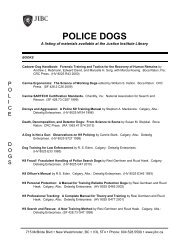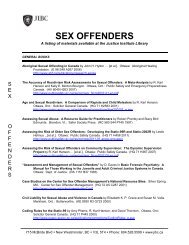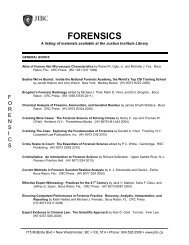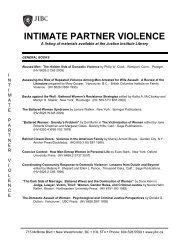legally speaking - Justice Institute of British Columbia
legally speaking - Justice Institute of British Columbia
legally speaking - Justice Institute of British Columbia
You also want an ePaper? Increase the reach of your titles
YUMPU automatically turns print PDFs into web optimized ePapers that Google loves.
RE-ENACTMENT NOTHING<br />
MORE THAN A STATEMENT BY<br />
CONDUCT<br />
R. v. Ashmore, 2011 BCCA 18<br />
The police obtained a wiretap<br />
a u t h o r i z a t i o n a n d b e g a n a n<br />
undercover operation following a<br />
murder. The accused was befriended<br />
by an undercover <strong>of</strong>ficer in a “Mr.<br />
Big” style operation and told the <strong>of</strong>ficer how he had<br />
strangled the victim and that the killing had been<br />
carried out at the request <strong>of</strong> the victim’s common<br />
law spouse. He, along with three others, was<br />
arrested at about 3pm on a Friday. He was told he<br />
was being arrested for first degree murder; he faced<br />
the possibility <strong>of</strong> life imprisonment; he had the right<br />
to retain and instruct counsel in private without<br />
delay; he could call any lawyer <strong>of</strong> his choosing;<br />
there was a 24-hour telephone service available if he<br />
wished to speak to a legal aid duty counsel in<br />
private; he may be monitored by audio-video<br />
surveillance while in custody, except while <strong>speaking</strong><br />
with counsel in private; and he had the right to<br />
remain silent, but that anything he said may be given<br />
in evidence. He said that he did not have a lawyer<br />
and he wished to speak with legal aid duty counsel.<br />
He was taken to police headquarters, and was<br />
processed and booked into the cellblock area.<br />
At police headquarters the accused was taken to a<br />
private telephone room. Police confirmed that he<br />
wanted to speak with legal aid duty counsel and an<br />
<strong>of</strong>ficer placed a call to the 24-hour legal aid number,<br />
leaving a message asking for a return call. A lawyer<br />
returned the call, was told that the accused had<br />
been arrested for first degree murder, and a private<br />
two and one-half to three minute conversation<br />
followed. After the call the accused indicated that he<br />
was satisfied with the opportunity he had been given<br />
to contact counsel. He spent the night in a cell and<br />
at about 9 am the following morning (Saturday) he<br />
participated in a teleconference hearing before a<br />
Judicial <strong>Justice</strong> <strong>of</strong> the Peace (JJP) who ordered him<br />
detained in custody in accordance with s. 515(11) <strong>of</strong><br />
the Criminal Code. He was to be conveyed “to a<br />
prison in the Province <strong>of</strong> <strong>British</strong> <strong>Columbia</strong> being<br />
Volume 11 Issue 1 - January/February 2011<br />
PAGE 23<br />
either a federal institution, a provincial institution or<br />
a police lockup” and to appear before a Provincial<br />
Court judge on Monday. After the hearing the<br />
accused was returned to his cell. At 1:15 pm that<br />
day he was interviewed for two hours at police<br />
headquarters. Part way through the interview the<br />
police played a video clip <strong>of</strong> the accused admitting<br />
to the undercover <strong>of</strong>ficer that he participated in the<br />
murder. After seeing the clip the accused confessed<br />
his involvement and described in detail his role and<br />
the roles <strong>of</strong> the other parties. At the end <strong>of</strong> the<br />
interview he agreed to participate in a reenactment.<br />
He was then returned to his cell.<br />
About three hours later the accused was taken from<br />
his cell to a different interview room at police<br />
headquarters for a re-enactment. He was advised<br />
that it was up to him whether he participated in it<br />
and that he had the right to consult with a<br />
lawyer. He said that he wished to speak with his<br />
girlfriend’s lawyer and was told that those<br />
arrangements could be made. When he then stated<br />
“Let’s just do the re-enactment”, the <strong>of</strong>ficer advised<br />
him that his participation was “strictly voluntary”<br />
and confirmed with the accused that he was “sure”<br />
he did not want to speak with a lawyer. The <strong>of</strong>ficer<br />
also confirmed that he had a right to consult a<br />
lawyer before participating in the re-enactment, was<br />
not obliged to say anything, and anything he did say<br />
may be given in evidence.<br />
Using a drawing <strong>of</strong> the apartment the accused<br />
described how events unfolded. Further reenactments<br />
then proceeded in three stages: (1) at<br />
another police station furniture was arranged to<br />
replicate the room in the apartment where the<br />
murder occurred and the accused demonstrated how<br />
the victim had been killed and how his body had<br />
been removed from the apartment; (2) at the<br />
apartment building where the murder occurred the<br />
accused demonstrated how the body had been taken<br />
down a stairwell and placed in a vehicle; and (3)<br />
where the body was dumped the accused<br />
demonstrated how he had disposed <strong>of</strong> it. On the<br />
way back to police headquarters the <strong>of</strong>ficer<br />
suggested that the accused call his mother, which he<br />
did the following day on Sunday (Mother’s Day).<br />
During this conversation the accused admitted his<br />
involvement in the murder. It was recorded.






